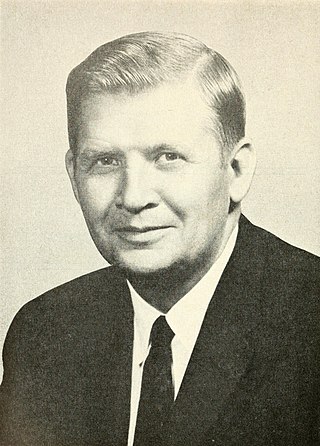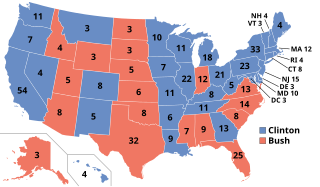
Duncan McLauchlin "Lauch" Faircloth was an American politician and farmer who served one term as a Republican U.S. Senator from North Carolina.

James Terry Sanford was an American lawyer and politician from North Carolina. A member of the Democratic Party, Sanford served as the 65th Governor of North Carolina from 1961 to 1965, was a two-time U.S. presidential candidate in the 1970s, and served as a U.S. senator from 1986 to 1993. He was a strong proponent of public education and introduced several reforms and new programs in North Carolina's schools and institutions of higher education as the state's governor. From 1970 to 1985, Sanford served as the president of Duke University.

James Thomas Broyhill was an American businessman and politician who served as a Republican U.S. Representative and Senator from the state of North Carolina. He represented much of the Foothills region of the state in the House from 1963 to 1986, and served in the United States Senate for four months in 1986.
Reagan's coattails refers to the influence of Ronald Reagan's popularity in elections other than his own, after the American political expression to "ride in on another's coattails". Chiefly, it refers to the "Reagan Revolution" accompanying his 1980 election to the U.S. presidency. This victory was accompanied by the change of twelve seats in the United States Senate from Democratic to Republican hands, producing a Republican majority in the Senate for the first time since 1954.

Sue Ellen Myrick is an American businesswoman and the former U.S. Representative for North Carolina's 9th congressional district, serving from 1995 to 2013. She is a member of the Republican Party. She was the first Republican woman to represent North Carolina in Congress. On February 7, 2012, she announced that she was retiring. She left Congress in January 2013 and was succeeded by Robert Pittenger.
Southern Democrats are affiliates of the U.S. Democratic Party who reside in the Southern United States.

The 1998 United States Senate elections were held on November 3, with the 34 seats of Class 3 contested in regular elections. This was seen as an even contest between the Republican Party and Democratic Party. While the Democrats had to defend more seats up for election, Republican attacks on the morality of President Bill Clinton failed to connect with voters and anticipated Republican gains did not materialize. The Republicans picked up open seats in Ohio and Kentucky and narrowly defeated Democratic incumbent Carol Moseley Braun (Illinois), but these were cancelled out by the Democrats' gain of an open seat in Indiana and defeats of Republican Senators Al D'Amato and Lauch Faircloth. The balance of the Senate remained unchanged at 55–45 in favor of the Republicans.

The 1996 United States Senate elections were held on November 5, with the 33 seats of Class 2 contested in regular elections. Special elections were also held to fill vacancies. They coincided with the presidential election of the same year, in which Democrat Bill Clinton was re-elected president.

The 1992 United States Senate elections, held November 3, 1992, were elections for the United States Senate. The 34 seats of Class 3 were contested in regular elections, along with special elections to fill vacancies. They coincided with Bill Clinton's victory in the presidential election. This was the first time since 1956 that the balance of the Senate remained the same.

The 1986 United States Senate elections were elections for the United States Senate. Held on November 4, in the middle of Ronald Reagan's second presidential term, the 34 seats of Class 3 were contested in regular elections. The Republicans had to defend an unusually large number of freshman Senate incumbents who had been elected on President Ronald Reagan's coattails in 1980. Democrats won a net of eight seats, defeating seven freshman incumbents, picking up two Republican-held open seats, and regaining control of the Senate for the first time since January 1981. This remains the most recent midterm election cycle in which the sitting president's party suffered net losses while still flipping a Senate seat.

The 1980 United States Senate elections were held on November 4, coinciding with Ronald Reagan's victory in the presidential election. The 34 Senate seats of Class 3 were contested in regular elections. Reagan's large margin of victory over incumbent Jimmy Carter gave a huge boost to Republican Senate candidates, allowing them to flip 12 Democratic seats and win control of the chamber for the first time since the end of the 83rd Congress in January 1955.

The 2010 United States Senate elections were held on November 2, 2010, from among the United States Senate's 100 seats. A special election was held on January 19, 2010, for a mid-term vacancy in Massachusetts. Thirty-four of the November elections were for six-year terms to the Senate's Class 3, while other three were special elections to finish incomplete terms. Those 37 November elections featured 19 incumbent Democrats and 18 incumbent Republicans.

The 1968 United States Senate elections were elections for the United States Senate. Held on November 5, the 34 seats of Class 3 were contested in regular elections. They coincided with the presidential election of the same year. The Republicans picked up five net seats in the Senate. This saw Republicans win a Senate seat in Florida for the first time since Reconstruction.

The 1966 United States Senate elections were elections on November 8, 1966 for the United States Senate which occurred midway through the second term of President Lyndon B. Johnson. The 33 seats of Class 2 were contested in regular elections. Special elections were also held to fill vacancies. With divisions in the Democratic base over the Vietnam War, and with the traditional mid-term advantage of the party not holding the presidency, the Republicans took three Democratic seats, thereby breaking Democrats' 2/3rds supermajority. Despite Republican gains, the balance remained overwhelmingly in favor of the Democrats, who retained a 64–36 majority. Democrats were further reduced to 63-37, following the death of Robert F. Kennedy in June 1968.

The 2010 United States Senate election in North Carolina was held on November 2, 2010. The filing deadline for the primaries was February 26; the primaries were held on May 4, with a Democratic primary runoff held on June 22. Incumbent Republican U.S. Senator Richard Burr won re-election to a second term. Burr is the first incumbent to win re-election for this seat since Sam Ervin's last re-election in 1968.

The 2014 United States Senate elections were held on November 4, 2014. A total of 36 seats in the 100-member U.S. Senate were contested. Thirty-three Class 2 seats were contested for regular six-year terms to be served from January 3, 2015, to January 3, 2021, and three Class 3 seats were contested in special elections due to Senate vacancies. The elections marked 100 years of direct elections of U.S. senators. Going into the elections, 21 of the contested seats were held by the Democratic Party, while 15 were held by the Republican Party.

The 1998 United States elections were held on November 3, 1998, in the middle of Democratic President Bill Clinton's second term and during impeachment proceedings against the president as a result of the Clinton–Lewinsky scandal. Though Republicans retained control of both chambers of Congress, the elections were unusual because this is the first midterm since 1934 that the president's party gained seats in the House of Representatives.

The 1998 United States Senate election in North Carolina was held November 3, 1998. Incumbent Republican U.S. Senator Lauch Faircloth decided to seek re-election to a second term, but was unseated by Democrat John Edwards, a trial attorney. As of 2023, this is the last time a Democrat won North Carolina's class 3 Senate seat. Edwards declined to run for reelection in 2004.

The 1986 United States Senate election in North Carolina was held on November 4, 1986 as part of the nationwide elections to the Senate. Incumbent Republican U.S. Senator Jim Broyhill, who had been appointed in June 1986 to serve out the rest of John Porter East's term, faced off against the popular Democratic former Governor Terry Sanford.

The 1992 United States elections elected state governors, the President of the United States, and members of the 103rd United States Congress. The election took place after the Soviet Union crumbled and the Cold War ended, as well as the redistricting that resulted from the 1990 census. Often considered "The Year Of The Woman," these elections brought an increased number of female politicians to Washington such as Dianne Feinstein (D-CA) and Carol Moseley Braun (D-IL). Governor Bill Clinton of Arkansas defeated incumbent President George H. W. Bush and businessman Ross Perot in the presidential election. The Democratic Party maintained their control of both chambers of Congress. This is the first Democratic trifecta since the Republican victory in the 1980 elections and the last one during the 20th century and the last one overall until 2008.


















